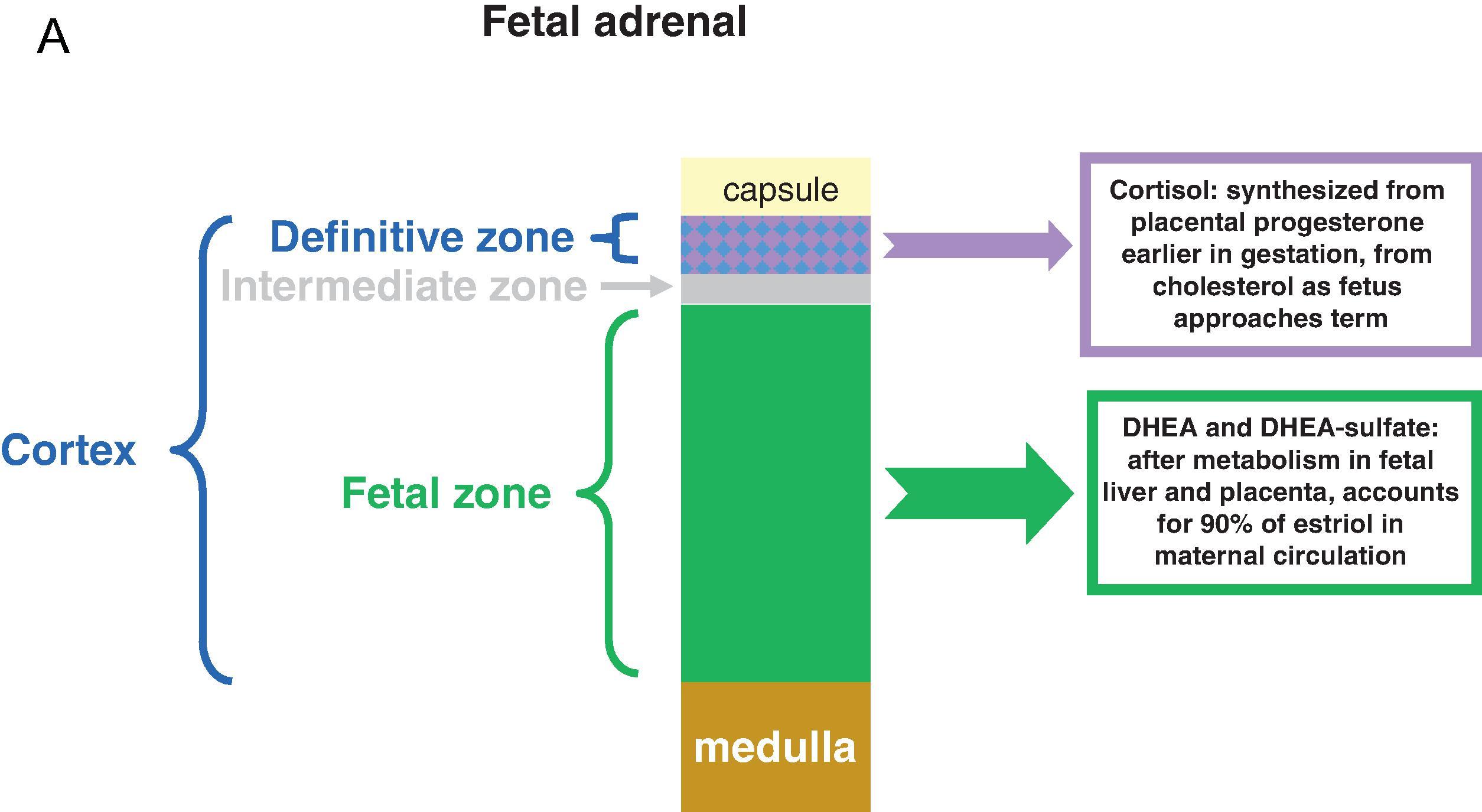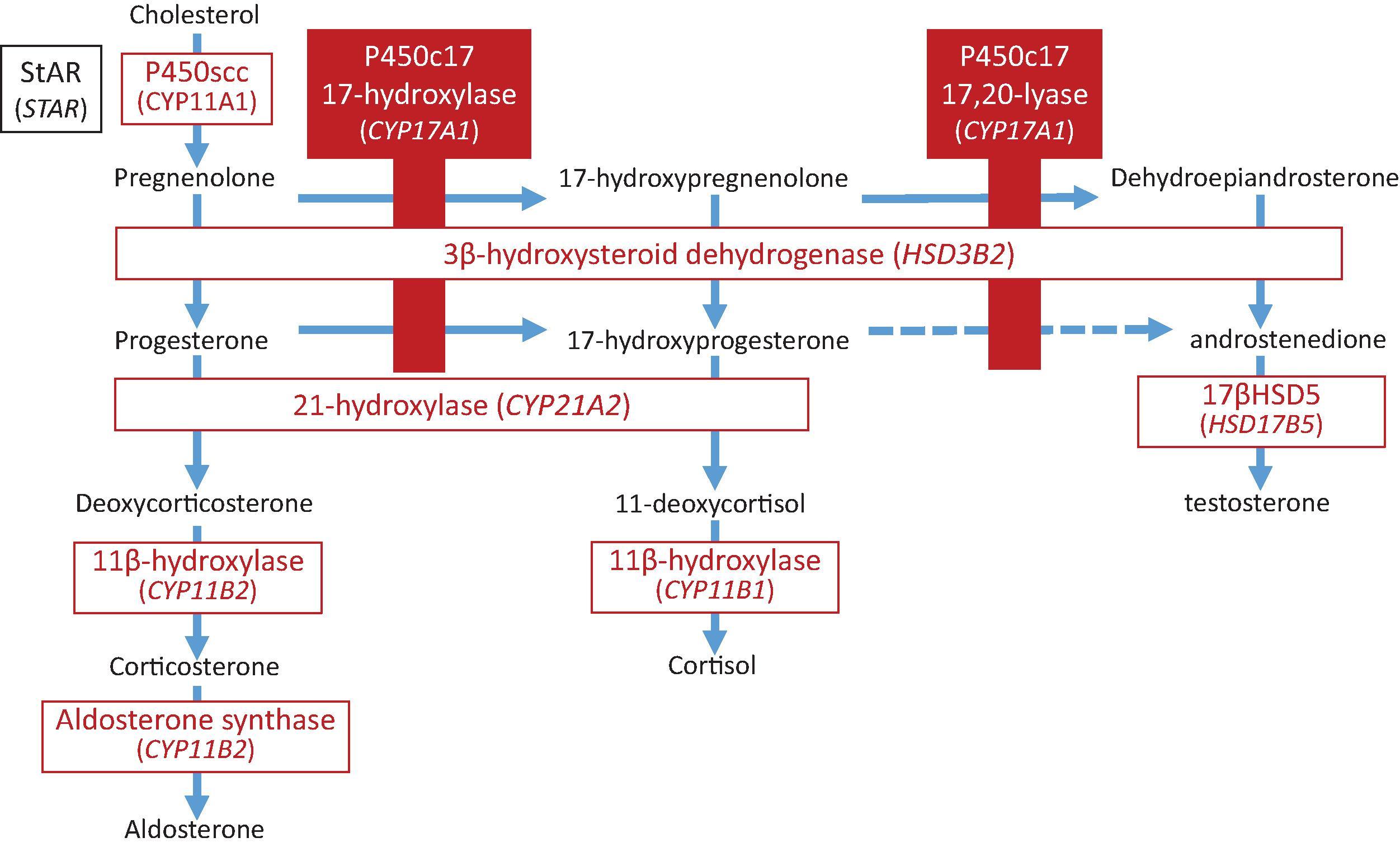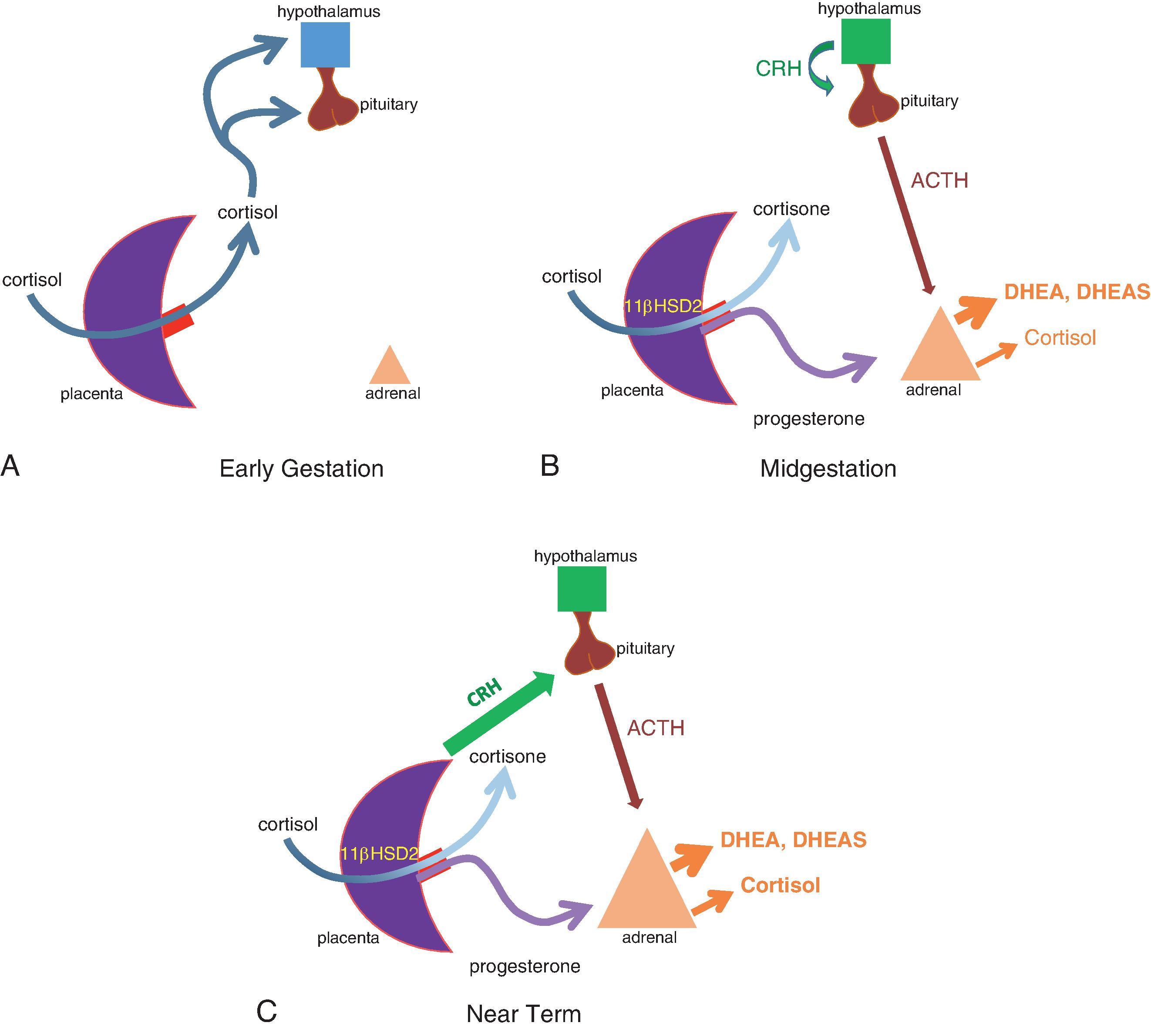Physical Address
304 North Cardinal St.
Dorchester Center, MA 02124
Normal hypothalamic-pituitary-adrenal (HPA) axis production of cortisol and a normal renin-angiotensin-aldosterone axis are needed for the normal regulation of volume status, blood pressure, and serum sodium, potassium and glucose levels in the neonate. Disorders of these axes can be life-threatening.
Cortisol deficiency can be due to a disorder of the adrenal gland itself or to impaired ACTH secretion from the pituitary gland.
Mineralocorticoid deficiency can result from deficient production of aldosterone from the adrenal gland or from impaired mineralocorticoid signaling.
A disorder of sex development, resulting in virilization of a 46,XX fetus or undervirilization of a 46,XY fetus, may indicate an underlying disorder of adrenal steroid synthesis.
Transient, relative glucocorticoid deficiency can occur in all newborns in the transition to extrauterine life. This may be exacerbated in the premature infant due to immaturity of the HPA axis and as a consequence of critical illness.
The adrenal glands sit on top of the upper pole of each kidney. The inner adrenal medulla produces catecholamines, predominantly epinephrine, which protect against hypotension and hypoglycemia. There are no significant disorders of the adrenal medulla during infancy. The adrenal cortex produces steroid hormones: aldosterone (a mineralocorticoid); cortisol (a glucocorticoid); and androgens, predominantly dehydroepiandrosterone (DHEA) and dehydroepiandrosterone sulfate (DHEAS). Mineralocorticoid action regulates the body’s fluid volume and serum potassium level, whereas glucocorticoids have a wide range of actions, including controlling the immune response and protecting against hypoglycemia and hypotension. The role of glucocorticoids to protect against hypoglycemia and hypotension are particularly important during times of stress, when healthy individuals will increase cortisol secretion by as much as 10-fold. Neonatal disorders of the adrenal cortex include those that result in deficiency of mineralocorticoid and glucocorticoid action and those that cause excessive mineralocorticoid and androgen action.
The cells of the adrenal cortex are of mesodermal origin whereas the cells of the adrenal medulla are from the neuroectoderm. Adreno-gonadal progenitor cells appear around the 4th week of gestation, and these cells give rise to steroidogenic cells of the gonads and adrenal cortex around the 7th to 8th weeks of gestation. The complete hypothalamic-pituitary-adrenal (HPA) axis is established by 20 weeks of gestation. The fetal adrenal cortex ( Fig. 27.1A ) consists of a relatively small outer definitive zone and a larger fetal zone. At about midgestation, a transitional zone develops between the definitive and fetal zones. During fetal life, the fetal zone produces large amounts of DHEA and DHEAS, which serve as precursors for placental estrogen production. The definitive zone of the fetal adrenal can produce glucocorticoid and mineralocorticoid. The role of the transitional zone is unclear, although it may be a site of fetal cortisol synthesis. Fetal adrenal glands grow through the third trimester. At birth, they are the same size as adult adrenal glands, that is, they are very large relative to body size. After birth the fetal zone involutes and disappears by about 6 to 12 months of age, with a concomitant decrease in the size of the infant adrenal gland. After birth, while the fetal zone is involuting, the definitive zone slowly enlarges and ultimately forms the three distinct zones of the fully developed adrenal cortex ( Fig. 27.1B ): the outer zona glomerulosa, which produces aldosterone; the middle zona fasciculata, which produces cortisol; and the inner zona reticularis, which produces DHEA, DHEAS, and androstenedione. The glomerulosa and fasciculata zones are not fully differentiated until about 3 years of age, whereas the zona reticularis does not begin to differentiate until after 3 years of age and is not fully developed until 15 years of age.

Steroid hormones are produced using cholesterol as the precursor. Although the adrenal gland can make cholesterol de novo from acetate, most of the cholesterol for postnatal steroid synthesis comes from plasma low-density lipoprotein from dietary cholesterol. The synthetic pathway of adrenal steroid synthesis is shown in Fig. 27.2 . The expression of a subset of the enzymes in the synthetic pathway results in temporal and zone-specific expression of the steroid hormones. Note that although the postnatal adrenal gland makes little or no testosterone, there is evidence that the fetal adrenal gland can synthesize testosterone through the expression of 17β-hydroxysteroid dehydrogenase 5 (17βHSD5). In virilizing forms of congenital adrenal hyperplasia, this adrenal testosterone production can be significant and contributes to the virilization of female fetuses.

In the first half of gestation, maternal cortisol crosses the placenta, inhibiting the fetal HPA axis ( Fig. 27.3A ). However, starting at midgestation and increasing through the last trimester, there is increased expression of placental 11β-hydroxysteroid dehydrogenase type 2 (11βHSD2), whose activity converts cortisol to the inactive cortisone ( Fig. 27.3B ). This limits exposure of the fetus to maternal glucocorticoid, decreasing the negative feedback effect on the fetal HPA axis and resulting in an increase in fetal ACTH production. , Although all the enzymes necessary for the synthesis of cortisol are expressed in the developing adrenal gland very early in gestation, by 14 weeks of gestation, 3β-hydroxysteroid dehydrogenase 2 (3βHSD2) is no longer expressed. Until expression of 3βHSD2 returns in the definitive zone (and possibly the intermediate zone) later in gestation, the fetal adrenal cannot synthesize cortisol from cholesterol. This lack of 3βHSD2 expression drives the production of DHEA and DHEAS by the fetal zone. Prior to expression of 3βHSD2 later in gestation, the fetal adrenal can synthesize cholesterol, but it does so by utilizing placental progesterone as the substrate. It is not until after 30 weeks’ gestation that the fetal adrenal typically produces cortisol de novo from cholesterol. Thus infants born at less than 27 to 30 weeks’ gestational age may have more impairment in the HPA axis than infants born at a later gestational age. For infants born after 27 weeks’ gestational age, serum cortisol levels over the first week of life change in response to illness, with infants who are ill showing a rise in serum cortisol and well infants having a decline in serum cortisol. In contrast, serum cortisol levels decrease in infants born prior to 27 weeks’ gestational age, whether they are ill or well. This transient adrenal insufficiency of prematurity seems to be limited to the first 2 weeks of life. A final unique aspect of the fetal HPA axis is that the placenta produces corticotropin releasing hormone (CRH), with the production increasing through the end of gestation (see Fig. 27.3C ). At that time, fetal ACTH is stimulated by the high circulating levels of placental CRH, with suppression of fetal hypothalamic CRH.

Although the enzymes necessary for the production of aldosterone are present in the fetus, mineralocorticoid production is only required postnatally.
The presentation of neonates and infants with disorders of the adrenal gland and the HPA axis depends on which class of adrenal hormone production is disrupted. If there is impairment of mineralocorticoid signaling, the infant may present with acute life-threatening dehydration and hyponatremia and hyperkalemia. Mineralocorticoid deficiency can also present in infancy with a subacute or chronic presentation of failure to thrive. Glucocorticoid deficiency can present with hypotension and hypoglycemia; the hypotension is compounded by the dehydration that occurs with mineralocorticoid deficiency if that is also present. When the adrenal insufficiency is due to hypopituitarism, there is glucocorticoid deficiency, but there is not mineralocorticoid deficiency, because aldosterone production is under control of the renin-angiotensin system, not ACTH. Disorders of adrenal androgen production can result in a disorder of sexual development, presenting as ambiguous genitalia in the newborn.
Primary adrenal insufficiency refers to disorders of the adrenal cortex, whereas central adrenal insufficiency refers to glucocorticoid deficiency as a result of impaired ACTH secretion. Depending on the underlying cause, primary adrenal insufficiency can result in mineralocorticoid deficiency in addition to glucocorticoid deficiency. The main causes of adrenal insufficiency in the neonate are listed in Table 27.1 . Primary adrenal insufficiency can occur because of underdevelopment of the adrenal gland or impaired function of the adrenal gland.
| Primary adrenal insufficiency |
| Disorders of adrenal gland development |
| Adrenal hypoplasia congenital (AHC): DAX1 mutation |
| Isolated DAX1 mutation |
| Xp21 continuous gene deletion |
| Mutations of SF1 |
| IMAGe syndrome |
| MIRAGE syndrome |
| Impaired adrenal gland function |
| Isolated glucocorticoid deficiency |
| Familial glucocorticoid deficiency |
| Metabolic disorders |
| Congenital adrenal hyperplasia |
| 21-Hydroxylase deficiency |
| 11-Hydroxylase deficiency |
| 3BHSD-deficiency |
| 17-Hydroxylase deficiency |
| Congenital lipoid adrenal hyperplasia |
| StAR deficiency |
| P450SCC deficiency |
| P450 Oxidoreductase Deficiency (Antler-Bixley Syndrome) |
| Smith-Lemli-Opitz Syndrome |
| Adrenal hemorrhage |
| Disorders of the renin-angiotensin-aldosterone axis |
| Aldosterone synthase deficiency |
| Pseudohypoaldosteronism (PHA) |
| Autosomal dominant PHA, NR3C2 mutations |
| Autosomal recessive, systemic PHA, ENaC mutations |
| Secondary to renal disease |
| Central adrenal insufficiency |
| Hypopituitarism |
| Developmental |
| Postinjury |
| Suppression of HPA axis from exogenous glucocorticoid treatment |
| Treatment of the infant |
| Maternal treatment during gestation |
| Relative adrenal insufficiency |
| Illness-associated |
| Immaturity of the HPA axis |
Become a Clinical Tree membership for Full access and enjoy Unlimited articles
If you are a member. Log in here